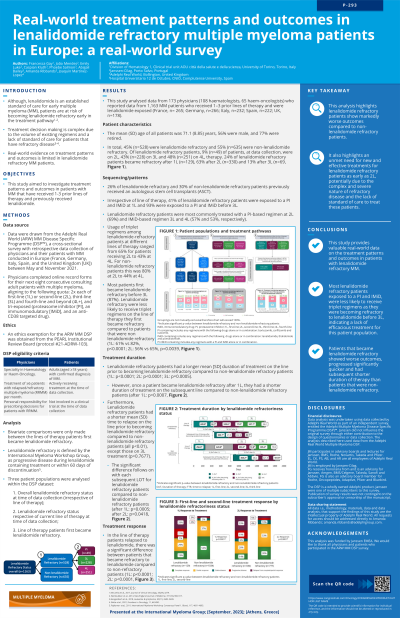Treatment of Relapsed/Refractory Myeloma
Poster Session 2
P-293: Real-World Treatment Patterns and Outcomes in Lenalidomide Refractory Multiple Myeloma Patients in Europe: A Real-World Survey
Thursday, September 28, 2023
12:30 PM - 1:30 PM EEST


Joaquín Martínez-López, PhD
Hematologist
Hematología Hospital 12 de Octubre, Madrid, Spain, Spain
Introduction: Lenalidomide (LEN) is a standard treatment (tx) for multiple myeloma (MM), given in earlier tx lines until disease progression, with many patients (pts) becoming refractory (Ref) to LEN. Real-world data on tx patterns and outcomes in LEN Ref MM pts in earlier lines of therapy (LOT) is limited.
Methods: Data were drawn from the Adelphi MM Disease Specific Programme™, a cross-sectional survey with retrospective data collection of haematologists/haem-oncologists conducted in Europe between May-Nov 2021. Physicians completed online record forms for their next 8 consulting adult pts with a confirmed diagnosis of MM and actively receiving tx. This included pts receiving: first line (1L) or second line (2L); third line (3L); fourth line and beyond (4L+); and tri-exposed (exposed to a proteasome inhibitor [PI], an immunomodulatory [IMiD], and an anti-CD38 targeted drug). Full tx history was collected, and only pts exposed to LEN who had received 1-3 prior LOT were analysed.
Two patient populations were analysed: (1) LEN Ref status (LEN Ref and non-LEN Ref) at time of data collection and (2) LOT pts first became LEN Ref. Bivariate comparisons were made between the LOT pts first became LEN Ref. LEN Ref is defined by the International Myeloma Working Group, as progressive disease during LEN tx or within 60 days of discontinuation.
Results: Of 1163 pts exposed to LEN who received 1-3 prior LOT, 528 (45%) were LEN Ref. Mean age was 71.1 years, 56% were male, and 77% were retired. 26% of LEN Ref and 30% of non-LEN Ref pts previously received an autologous stem cell transplant (ASCT).
Of all LEN Ref pts, 41% had exposure to a PI and IMiD at 1L, 93% before 3L. 71% of LEN Ref pts with prior ASCT (n=137) received a PI and IMiD at 1L, 96% before 3L. For non-ASCT LEN Ref pts (n=391), 30% received a PI and IMiD at 1L, 90% before 3L.
Of the LEN Ref pts, 24% (n=129) first became Ref after 1L, 63% (n=330) after 2L and 13% (n=69) after 3L. Pts that became LEN Ref before 3L (87%) were less likely to receive triplet regimens on the LOT they became Ref vs non-LEN Ref (1L: 61% vs 82%, p< 0.0001; 2L: 56% vs 65%, p=0.0039).
LEN Ref pts, compared to non-LEN Ref, had a longer mean [SD] duration of therapy (DoT) (1L: 14.1 vs 8.4 months, p< 0.0001; 2L: 17.74 vs 12.9, p< 0.0001) on the line they first became LEN Ref or were exposed to LEN (non-LEN Ref). After pts became LEN Ref, DoT (after 1L: 10.1 vs 15.1, p=0.0007; after 2L: 13.2 vs 13.9, p=0.544) and time to relapse (after 1L: 11.4 vs 18.4, p=0.0005; after 2L: 8.4 vs 11.0, p=0.0418) worsens compared to non-LEN Ref pts.
Conclusions: This analysis shows most LEN Ref pts were exposed to a PI and IMiD, while also becoming refractory to LEN before they reach 3L. These LEN Ref pts had significantly faster progression and were less likely to receive treatment with triplets, showing shorter DoT and time to relapse compared to pts non-LEN Ref. There is an unmet need for new and effective tx for LEN-ref pts as early as the 2L.
Methods: Data were drawn from the Adelphi MM Disease Specific Programme™, a cross-sectional survey with retrospective data collection of haematologists/haem-oncologists conducted in Europe between May-Nov 2021. Physicians completed online record forms for their next 8 consulting adult pts with a confirmed diagnosis of MM and actively receiving tx. This included pts receiving: first line (1L) or second line (2L); third line (3L); fourth line and beyond (4L+); and tri-exposed (exposed to a proteasome inhibitor [PI], an immunomodulatory [IMiD], and an anti-CD38 targeted drug). Full tx history was collected, and only pts exposed to LEN who had received 1-3 prior LOT were analysed.
Two patient populations were analysed: (1) LEN Ref status (LEN Ref and non-LEN Ref) at time of data collection and (2) LOT pts first became LEN Ref. Bivariate comparisons were made between the LOT pts first became LEN Ref. LEN Ref is defined by the International Myeloma Working Group, as progressive disease during LEN tx or within 60 days of discontinuation.
Results: Of 1163 pts exposed to LEN who received 1-3 prior LOT, 528 (45%) were LEN Ref. Mean age was 71.1 years, 56% were male, and 77% were retired. 26% of LEN Ref and 30% of non-LEN Ref pts previously received an autologous stem cell transplant (ASCT).
Of all LEN Ref pts, 41% had exposure to a PI and IMiD at 1L, 93% before 3L. 71% of LEN Ref pts with prior ASCT (n=137) received a PI and IMiD at 1L, 96% before 3L. For non-ASCT LEN Ref pts (n=391), 30% received a PI and IMiD at 1L, 90% before 3L.
Of the LEN Ref pts, 24% (n=129) first became Ref after 1L, 63% (n=330) after 2L and 13% (n=69) after 3L. Pts that became LEN Ref before 3L (87%) were less likely to receive triplet regimens on the LOT they became Ref vs non-LEN Ref (1L: 61% vs 82%, p< 0.0001; 2L: 56% vs 65%, p=0.0039).
LEN Ref pts, compared to non-LEN Ref, had a longer mean [SD] duration of therapy (DoT) (1L: 14.1 vs 8.4 months, p< 0.0001; 2L: 17.74 vs 12.9, p< 0.0001) on the line they first became LEN Ref or were exposed to LEN (non-LEN Ref). After pts became LEN Ref, DoT (after 1L: 10.1 vs 15.1, p=0.0007; after 2L: 13.2 vs 13.9, p=0.544) and time to relapse (after 1L: 11.4 vs 18.4, p=0.0005; after 2L: 8.4 vs 11.0, p=0.0418) worsens compared to non-LEN Ref pts.
Conclusions: This analysis shows most LEN Ref pts were exposed to a PI and IMiD, while also becoming refractory to LEN before they reach 3L. These LEN Ref pts had significantly faster progression and were less likely to receive treatment with triplets, showing shorter DoT and time to relapse compared to pts non-LEN Ref. There is an unmet need for new and effective tx for LEN-ref pts as early as the 2L.
